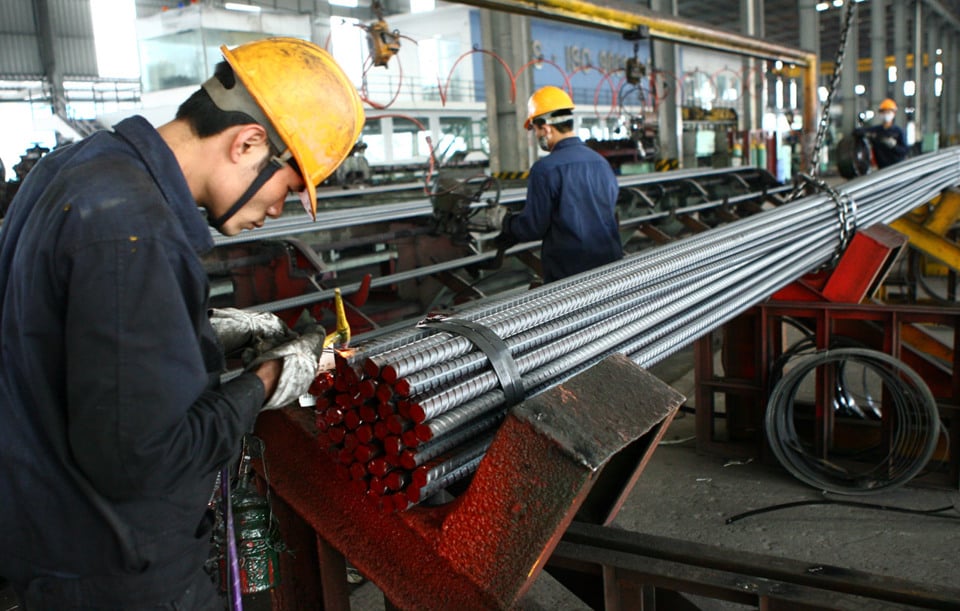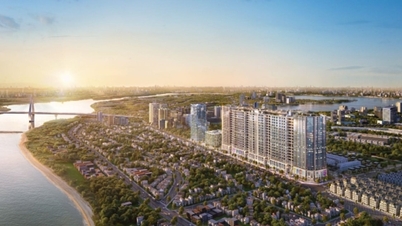Demand for home repairs and new construction is increasing slowly.
Reporters from Kinh tế & Đô thị (Economy & Urban Affairs) at steel dealers in Hanoi observed that steel prices have been continuously increasing since the beginning of October and are currently fluctuating around 14 million VND/ton. Since October 2nd, steel prices have been adjusted upwards four times consecutively for CB240 coiled steel and D10 CB300 ribbed bars.
Specifically, in the Northern market, Hoa Phat steel prices, with CB240 coiled steel, increased by 310,000 VND/ton, currently fluctuating at 13.8 million VND/ton; D10 CB300 ribbed steel bars increased by 410,000 VND/ton, priced at nearly 14 million VND/ton.
For Viet Duc Steel, CB240 steel coils are priced at 13.6 million VND/ton; D10 CB300 ribbed steel bars are priced at over 14 million VND/ton. For VAS Steel, CB240 steel coils and D10 CB300 ribbed steel bars are priced at 13.85 million VND/ton and 14 million VND/ton respectively.

According to the Vietnam Steel Association (VSA), the Vietnamese steel market continues to show positive recovery in both domestic and export demand. Total consumption of all types of steel in the first nine months of 2024 increased by 14.5% compared to the same period in 2023. Total consumption of construction steel in the first nine months of the year also increased by 12.5% compared to the same period last year, of which domestic consumption reached over 7.1 million tons, an increase of 11.1% compared to the same period.
In the first nine months of 2024, the galvanized steel market saw total exports reach nearly 2.4 million tons, a sharp increase of 44% compared to the same period in 2023. This created favorable conditions for cold-rolled steel businesses to boost consumption of finished steel products and related processing.
Meanwhile, other building materials such as cement maintain their selling prices at 220,000 - 270,000 VND/ton. To date, cement prices remain unchanged compared to the last price increase in June 2022.
According to dealers, the demand for home repairs and new construction has increased compared to the period before Typhoon No. 3 hit the North; however, due to price increases for some building materials, the demand is not as high as expected.
Mr. Nguyen Van Dung, the owner of a building materials store on Nguyen Phong Sac Street (Cau Giay District, Hanoi), said that although it is currently the construction season, fewer projects are starting, so sales are slow, down by 10-20% compared to previous years.
"The increase in the price of building materials, including steel, has significantly impacted the construction of individual houses in residential areas. Many families have to reconsider their home construction plans, as costs can increase by several million to tens of millions of dong," said Mr. Nguyen Van Dung.
Prices may continue to rise.
Under the impact of rising electricity prices, many experts believe this could affect businesses in the building materials industry, as electricity costs account for a significant proportion of production and business activities (10% for steel, 14-15% for cement).
While demand remains low, purchasing power is weak, and inventory levels are still high, businesses face challenges in adjusting operating costs. At the same time, construction material prices are expected to continue rising in the second half of 2024, provided the economy has stabilized and the construction industry has recovered.
According to a representative of the Vietnam Cement Corporation (Vicem), the electricity price increase was anticipated by the company. Although affected by various other input costs, the price increase is considered unavoidable given the difficulties the electricity sector faces due to rising input costs such as coal and oil. The company's plans also included provisions for the price increase and efforts to further reduce costs and use electricity more efficiently.
Meanwhile, in the steel industry, Master Pham Ngoc Trung - an expert in the field of building materials - assesses that electricity is considered one of the main energy consumption indicators in the steel production process, especially in the steelmaking stage using electric furnaces (electricity costs account for 7-8% of steel production).
Therefore, every time electricity prices increase, businesses in the steel industry face pressure from rising production costs. In addition, when electricity prices increase, other input costs often rise as well, which will undoubtedly have a significant impact on production costs.
"Businesses need to minimize input costs to reduce the impact; apply electricity saving measures and use energy efficiently (production during off-peak hours, increased coal injection and oxygen blowing during steelmaking...). This action will not only help minimize the impact of electricity price increases but also enhance the competitiveness of steel businesses. Product quality will improve, and prices will be more reasonable," said Mr. Pham Ngoc Trung.
According to a recent report by Shinhan Securities Vietnam, domestic steel production has improved thanks to the recovery of the domestic market. Domestic steel production will continue to grow due to the improving economy and the resurgence of the real estate market. The Real Estate Business Law, the Housing Law, and the Land Law, which are expected to take effect soon, along with increased public investment, will be the driving force behind continued growth in steel demand during the 2025-2026 period.
Experts at Shinhan Securities also noted that the recent increase in steel prices, along with the rise in Chinese steel prices, is driven by the Chinese government's more aggressive policies to revive the real estate market. Import and export activities showed strong growth in the first eight months of 2024, reaching 8.88 million tons, an increase of 20.7%, with construction steel and galvanized steel sheets growing by 34% and 47% respectively. Vietnam's steel product imports reached approximately 10.75 million tons, a 35.5% increase compared to the same period.
The Vietnam Electricity Group (EVN) issued Decision No. 1046/QD-EVN dated October 11, 2024, on adjusting the average retail electricity price. Accordingly, the average retail electricity price increased by 4.8%. Calculations by EVN show that the average monthly increase in electricity costs for business and service customers is VND 247,000; for production customers, VND 499,000; and for administrative and public service customers, VND 91,000.
Source: https://kinhtedothi.vn/thi-truong-vat-lieu-xay-dung-phuc-hoi-cham.html


![[Photo] Prime Minister Pham Minh Chinh receives the Governor of Tochigi Province (Japan)](/_next/image?url=https%3A%2F%2Fvphoto.vietnam.vn%2Fthumb%2F1200x675%2Fvietnam%2Fresource%2FIMAGE%2F2025%2F12%2F16%2F1765892133176_dsc-8082-6425-jpg.webp&w=3840&q=75)

![[Image] Leaked images ahead of the 2025 Community Action Awards gala.](/_next/image?url=https%3A%2F%2Fvphoto.vietnam.vn%2Fthumb%2F1200x675%2Fvietnam%2Fresource%2FIMAGE%2F2025%2F12%2F16%2F1765882828720_ndo_br_thiet-ke-chua-co-ten-45-png.webp&w=3840&q=75)

![[Photo] Prime Minister Pham Minh Chinh receives Lao Minister of Education and Sports Thongsalith Mangnormek](/_next/image?url=https%3A%2F%2Fvphoto.vietnam.vn%2Fthumb%2F1200x675%2Fvietnam%2Fresource%2FIMAGE%2F2025%2F12%2F16%2F1765876834721_dsc-7519-jpg.webp&w=3840&q=75)



































































![[Photo] Prime Minister Pham Minh Chinh attends the Vietnam Economic Forum 2025](https://vphoto.vietnam.vn/thumb/402x226/vietnam/resource/IMAGE/2025/12/16/1765893035503_ndo_br_dsc-8043-jpg.webp)




































Comment (0)